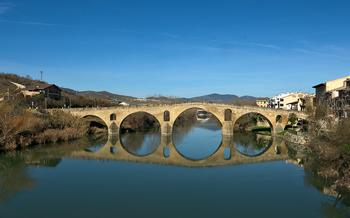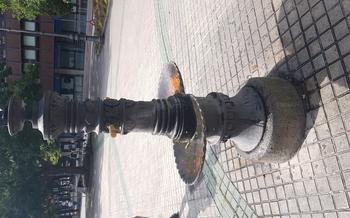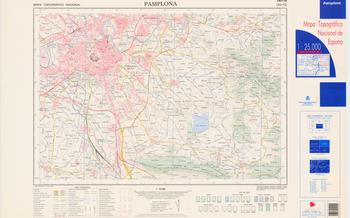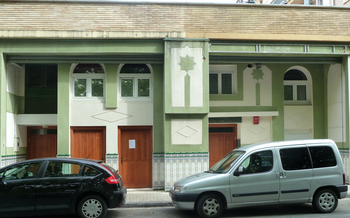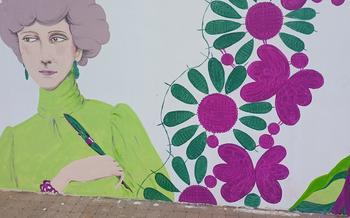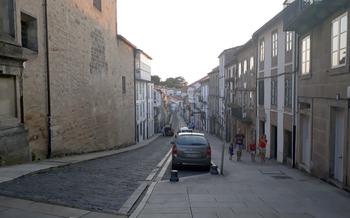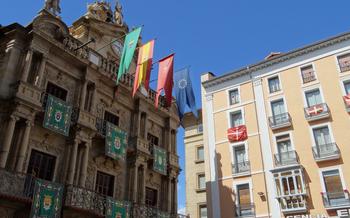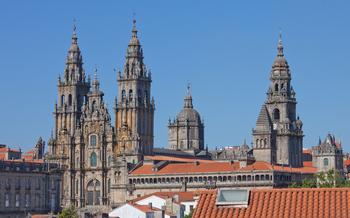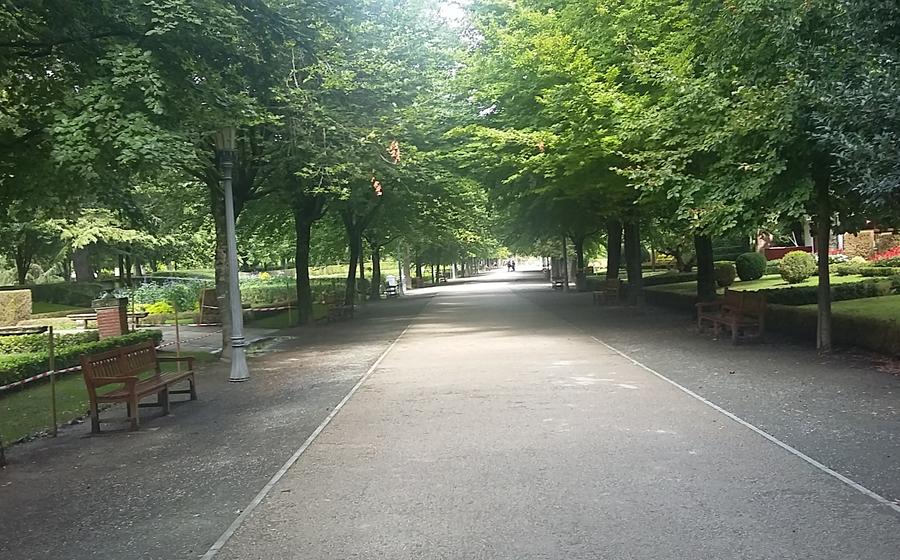
Jardines de la Taconera
- A Stroll Through History
- A Sanctuary for Wildlife
- The Citadel: A Majestic Fortress
- The Museum of Navarra: A Journey Through Art and History
- The Planetarium: Exploring the Cosmos
- The Basque Cuisine: A Culinary Delight
- The Navarran Mountains: A Natural Paradise
- The Art and Architecture of Pamplona
- Insider Tip: Discovering Hidden Gems
A Stroll Through History
The Jardines de la Taconera have a rich and storied past, dating back to the Middle Ages. The gardens were originally created as a hunting ground for the kings of Navarre, who ruled the region for centuries. Over time, the gardens evolved into a place of leisure and relaxation for the city's elite. In the 19th century, the gardens were opened to the public, and they quickly became a popular spot for locals and visitors alike.
Throughout their history, the Jardines de la Taconera have been the site of many notable events and have been associated with several prominent figures. In the 16th century, the gardens were used as a staging ground for the Spanish army during the War of the Spanish Succession. In the 19th century, the gardens were a popular gathering place for intellectuals and artists, including the writer Ernest Hemingway, who frequented the nearby Café Iruña.
Today, the Jardines de la Taconera are a living testament to their rich history. Visitors can still see the remains of the old hunting lodge, as well as several statues and monuments that commemorate the gardens' past. The gardens are also home to a number of historical trees, some of which are hundreds of years old.
In recent years, the Jardines de la Taconera have undergone a major renovation, which has restored them to their former glory. New walkways and flower beds have been added, and the gardens are now fully accessible to visitors with disabilities. The renovation has also included the addition of new historical markers, which provide visitors with more information about the gardens' past.
A Sanctuary for Wildlife
The Jardines de la Taconera serve as a haven for a diverse array of wildlife, contributing to the park's ecological significance. Among the avian inhabitants, visitors can spot common species such as sparrows, blackbirds, and doves, as well as more elusive birds like woodpeckers and goldfinches. The gardens' tranquil environment provides a suitable habitat for these feathered creatures, allowing them to thrive and nest within the park's lush greenery.
Beyond birds, the gardens offer refuge to a variety of other animal species. Squirrels playfully scamper among the trees, while lizards bask in the sun on warm afternoons. Visitors may also encounter rabbits hopping through the undergrowth, adding a touch of charm to the natural tapestry of the Jardines de la Taconera.
The park's commitment to biodiversity extends to conservation efforts that promote the well-being of its wildlife inhabitants. Native plant species are carefully selected to provide food and shelter for local fauna, creating a harmonious ecosystem within the gardens. Bird feeders and nesting boxes are strategically placed to support the avian population, while efforts are made to minimize human disturbance in sensitive areas.
Birdwatching enthusiasts will find the Jardines de la Taconera an ideal location to observe and photograph a wide range of bird species. The park's diverse habitats, from dense groves to open meadows, cater to a variety of birdlife. Whether you're an experienced birder or simply enjoy spotting colorful feathered friends, the gardens offer ample opportunities for wildlife encounters and unforgettable moments in nature.
The Citadel: A Majestic Fortress
The Citadel of Pamplona stands as a formidable testament to the city's rich history and resilience. Constructed in the 16th century, this pentagonal fortress played a crucial role in defending Pamplona against numerous sieges and conflicts. Its imposing walls, intricate bastions, and strategic location made it a formidable barrier against invading forces.
Over the centuries, the Citadel witnessed countless battles and sieges, serving as a refuge for the city's inhabitants during times of war. Its fortifications withstood the test of time, adapting to evolving military strategies and technologies. Today, the Citadel stands as a silent guardian of Pamplona's past, a symbol of its unwavering spirit and determination.
In the present day, the Citadel has been transformed into a vibrant cultural and leisure space, welcoming visitors to explore its historic grounds and discover its fascinating stories. Within its walls, visitors can wander through its well-preserved fortifications, admire the architectural details of its barracks and ramparts, and immerse themselves in the immersive exhibits that showcase the Citadel's military heritage.
As you stroll through the Citadel's cobbled streets, you can almost feel the echoes of history reverberating through the air. The Citadel's transformation into a cultural hub has breathed new life into this historic landmark, while preserving its legacy as a symbol of Pamplona's resilience and fortitude.
The Museum of Navarra: A Journey Through Art and History
A Treasure Trove of Artistic Heritage
The Museum of Navarra is a must-visit attraction for art enthusiasts and history buffs alike. Housed in a former hospital building dating back to the 16th century, the museum boasts a rich and diverse collection that spans from prehistoric times to contemporary art.
Highlights of the Collection
Among the highlights of the museum's collection are the Romanesque sculptures from the 12th and 13th centuries, including the famous "Cristo de Galilea" (Christ of Galilee). The museum also houses an impressive collection of Gothic and Renaissance art, including works by Juan de Anchieta and Pedro de Aponte.
Goya and Beyond
The museum's collection of modern and contemporary art is equally impressive, with a focus on Basque and Navarrese artists. One of the most renowned works in this section is "The Family of Charles IV" by Francisco Goya, a masterpiece of Spanish painting.
Temporary Exhibitions and Events
In addition to its permanent collection, the Museum of Navarra hosts temporary exhibitions and events throughout the year. These exhibitions often focus on specific themes or artists, providing visitors with an opportunity to explore different aspects of art and history.
Personal Anecdote
During my visit to the Museum of Navarra, I was particularly captivated by the Romanesque sculptures. The intricate carvings and expressive faces of the figures seemed to transport me back in time to a different era. I spent hours wandering through the galleries, admiring the skill and artistry of these medieval craftsmen.
The Planetarium: Exploring the Cosmos
Pamplona's Planetarium is a state-of-the-art facility that takes visitors on an awe-inspiring journey through the cosmos. Equipped with advanced technology and immersive visuals, the Planetarium offers a range of shows and programs that cater to all ages and interests.
Step into the captivating dome theater and be transported to the vastness of space. Witness the birth and evolution of stars, explore the mysteries of distant galaxies, and embark on a virtual tour of our solar system. The Planetarium's shows are both educational and entertaining, providing a deeper understanding of the universe we inhabit.
In addition to its regular shows, the Planetarium also hosts special events and workshops designed to foster a love of astronomy and space exploration. From hands-on activities for children to lectures by renowned astrophysicists, there's always something new to discover at the Planetarium.
Personal Anecdote:
During my visit to the Planetarium, I was particularly captivated by a show about the search for extraterrestrial life. The program explored the possibility of life beyond Earth, showcasing the latest scientific discoveries and theories. I left the Planetarium feeling inspired and curious, with a newfound appreciation for the vastness and complexity of the universe.
The Basque Cuisine: A Culinary Delight
The Basque Country is renowned for its exceptional cuisine, a harmonious blend of fresh local ingredients, traditional cooking techniques, and innovative culinary creations. Pamplona, the capital of Navarre, offers a delectable array of Basque culinary experiences that will tantalize your taste buds.
Indulge in the pintxos, small bites of culinary artistry that showcase the region's flavors. These bite-sized delights, ranging from classic to contemporary, are served in bars and restaurants throughout the city. Sample the croquetas, creamy croquettes filled with ham, cod, or mushrooms; the gildas, skewered anchovies, peppers, and olives; or the tortilla de patatas, a savory potato omelet.
For a hearty and comforting meal, savor the marmitako, a traditional Basque fish stew made with tuna, potatoes, peppers, and a flavorful broth. Or relish the txuleta, a thick, grilled steak from local beef, renowned for its exceptional quality and taste. Accompany your meal with a glass of txakoli, a refreshing, slightly sparkling white wine from the Basque Country.
Pamplona is home to an array of culinary gems, from traditional Basque restaurants to innovative fusion eateries. For an authentic experience, head to Bar Txoko for classic pintxos and Basque dishes in a lively atmosphere. Casa Marceliano offers a refined dining experience with a focus on seasonal ingredients and modern Basque cuisine. If you're looking for a unique culinary adventure, try Kabo, a gastrobar that fuses Basque flavors with international influences.
My personal favorite Basque dish is the alubias con sacramentos, a hearty and flavorful stew made with white beans, sacramental meats, and vegetables. The beans are cooked to perfection, soaking up the rich broth and flavors of the sacramental meats, creating a dish that is both comforting and delicious.
Whether you're a foodie seeking culinary adventures or simply looking for a delightful dining experience, Pamplona's Basque cuisine will surely satisfy your cravings. Embrace the vibrant culinary scene, indulge in the local flavors, and savor the unique gastronomic treasures that this region has to offer.
The Navarran Mountains: A Natural Paradise
Nestled in the heart of the Pyrenees, the Navarran mountains offer a breathtaking panorama of rugged peaks, lush valleys, and pristine lakes. This natural paradise is a haven for outdoor enthusiasts, inviting you to explore its diverse landscapes through a variety of activities.
Lace up your hiking boots and embark on a journey through the Navarran Pyrenees, where well-marked trails lead you past cascading waterfalls, blooming meadows, and ancient forests. Ascend to panoramic viewpoints and be rewarded with awe-inspiring vistas that stretch for miles. The mountains are also a haven for wildlife, so keep an eye out for marmots, chamois, and the majestic Pyrenean ibex.
For a thrilling experience, strap on your skis and glide down the slopes of one of the region's many ski resorts. With slopes for all levels, from beginners to experts, the Navarran Pyrenees offer a world-class skiing experience. Escape the crowds and discover the backcountry, where you can carve your own path through untouched powder.
Mountain biking enthusiasts will find endless trails that wind through forests, cross mountain streams, and offer exhilarating descents. The Navarran mountains are also a paradise for rock climbers, with towering cliffs and challenging routes that will put your skills to the test.
Whether you're seeking adventure, tranquility, or simply the chance to reconnect with nature, the Navarran mountains have something to offer everyone. So pack your bags, embrace the great outdoors, and let the beauty of the Pyrenees captivate your senses.
The Art and Architecture of Pamplona
Pamplona's streets are a testament to its rich history and cultural heritage, showcasing a harmonious blend of architectural styles that have shaped its cityscape over the centuries. From the imposing Gothic Cathedral to the elegant Town Hall, each landmark narrates a chapter in the city's evolution.
The Gothic Cathedral, a masterpiece of medieval architecture, dominates the skyline with its grandeur. Its intricate facade adorned with sculptures and gargoyles, tells stories from the Bible and the lives of saints. Inside, the soaring vaults and stained-glass windows create an atmosphere of awe and reverence.
In contrast, the Town Hall, built in the 18th century, exemplifies the elegance and symmetry of the Baroque style. Its elaborate facade features intricate carvings, balconies, and a majestic clock tower that chimes the hours. The interior boasts opulent halls and chambers, hosting important civic functions and events.
Beyond these iconic landmarks, Pamplona is adorned with hidden architectural gems waiting to be discovered. The neoclassical facade of the Museum of Navarra stands as a testament to the city's embrace of modern styles, while the futuristic Planetarium, with its sleek design, embodies Pamplona's forward-thinking spirit.
Strolling through the city's narrow streets, one can admire the charming blend of medieval and modern architecture. Pastel-colored buildings with intricate wrought-iron balconies line the cobblestone streets, creating a picturesque urban landscape.
Personal anecdotes:
During my visit to Pamplona, I stumbled upon a hidden gem nestled in a quiet corner of the Old Town. The Palacio de Ezpeleta, a 16th-century palace, captivated me with its Renaissance-style architecture. Its elegant facade adorned with intricate carvings and a majestic coat of arms hinted at the noble lineage of its former owners.
Another architectural highlight was the Church of San Nicolas, a lesser-known gem that surprised me with its stunning interior. The church's Baroque altarpiece, a masterpiece of gilded woodcarving, depicted scenes from the life of Saint Nicolas with intricate detail and vibrant colors.
These architectural discoveries, both grand and hidden, added depth and charm to my exploration of Pamplona, making it a city where history and modernity seamlessly intertwine.
Insider Tip: Discovering Hidden Gems
Beyond the well-known attractions, Pamplona holds a treasure trove of hidden gems waiting to be discovered. For a truly immersive experience, venture off the beaten path and explore the city's lesser-known corners.
One such gem is the Iglesia de San Nicolás, a small but enchanting church tucked away in the heart of the old town. Step inside to admire its intricate Gothic architecture and stunning stained-glass windows, a testament to the city's rich artistic heritage.
For a taste of local life, head to the Mercado de Santo Domingo, a bustling market where vendors sell fresh produce, artisanal cheeses, and traditional Basque delicacies. Engage with the friendly locals, sample local specialties, and soak up the vibrant atmosphere of this culinary haven.
Art enthusiasts will delight in the Museo Universidad de Navarra, which houses a diverse collection ranging from medieval paintings to contemporary installations. Immerse yourself in the works of local and international artists, and gain insights into the vibrant art scene of Pamplona.
Escape the city hustle and find tranquility in the Parque de Yamaguchi, a Japanese-inspired garden nestled on the outskirts of Pamplona. Stroll along serene paths, admire the meticulously landscaped gardens, and soak in the tranquil ambiance of this hidden oasis.
For a unique culinary experience, seek out the Bar Txoko hidden in the backstreets of the old town. This unassuming establishment serves authentic pintxos, small plates of Basque cuisine, that are bursting with flavor and creativity. Indulge in the local custom of bar hopping, sampling different pintxos at various bars, and immersing yourself in the vibrant culinary culture of Pamplona.
